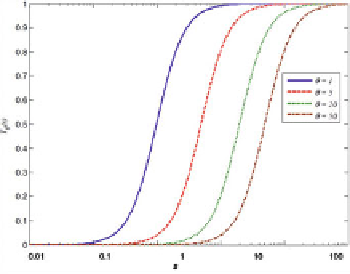Information Technology Reference
In-Depth Information
the different stimulus intensity, therefore, can assess the demand for a particular
task when are in contact with the stimulus associated.
Let
s
be the intensity of a stimulus associated with a particular task;
s
can
be a number of encounters, a chemical concentration, or any quantitative cue
sensed by individuals. A response threshold
θ
, expressed in units of stimulus
intensity, is an internal variable that determines the tendency of an individual
to response to the stimulus s and perform the associated task. More precisely,
θ
is such that the probability of response is low for
s<θ
andhighfor
s>θ
.This
mathematical model that satisfies this requirement is given by:
s
j
T
θij
(
s
j
)=
(
n>
1)
(1)
s
j
+
θ
ij
where
n>
1 determines the steepness of the threshold. Fig. 1 shows several such
response curves whit
n
= 2, for different values of
θ
. More clearly: for
s<θ
,
the probability of engaging task performance is close to 0, and for
s>θ
,this
probability is close to 1. Then, the probability than an individual will perform
a task depends on
s
.
Fig. 1.
Semi-logarithmic plot whit different thresholds (
θ
=1
,
5
,
20
,
50) and whit
n
=2
The underlying idea is very simple, when a stimulus exceeds the threshold
of response of an individual, that individual is likely to respond to stimuli, and
engage in the task because the level of the stimulus associated with that task
exceeds its threshold. The intensity of a stimulus decreases as the individual
performs the task; therefore, individuals with high thresholds are unlikely to
perform the task when other individuals, with lower thresholds, maintain the
stimulus intensity below their thresholds. However, when individuals with low
thresholds do not perform the task, individuals that have high thresholds may
engage in the task performance because the stimulus intensity exceeds their
thresholds.


Search WWH ::

Custom Search